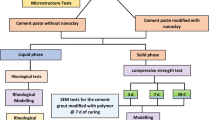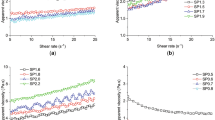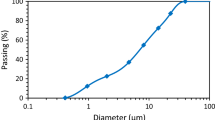Abstract
In this study, the effect of two water reducer polymers on the thermal stability, rheology, and compressive strength of Gasin Ordinary Cement (GC) was investigated. The behavior of cement in the liquid phase (slurry) and hardened phase modified with two types of polymer varied from 0 to 0.06% (%wt) were investigated. XRD and TGA tests were conducted to identify the effect of polymers on the behavior of GC. The compressive strength of cement mixed with polymers was tested from the early aged of 1 days to 28 days of curing. The shear stress versus shear strain rate of cement slurry was modeled and the results of prediction using Vipulanandan rheological model were compared to the Vocadlo model. High reduction in the total weight loss of the GC at 800 °C when the cement modified with 0.06% of polymers detected using TGA test. The rheological properties of the cement slurry such as viscosity, yield stress, and the compressive strength of GC were increased significantly with increasing the polymer contents. Addition of polymers reduced the required water to reach the desired fluidity by about 43% based on the type of polymer. The results showed that the Vipulanandan rheological model predicted the shear-thinning relationship between the shear stress and shear strain rate of the cement slurry modified polymers very well. Also, the Vipulanandan rheological model has a maximum shear stress limit were as the Vocadlo model did not have a limit on the maximum shear stress. Based on the Vipulanandan rheological model the maximum shear stress produced by the cement slurry modified with 0% and 0.06% of polymers at the temperature of 25 °C were increased from 38.7 to 171.3 Pa and to 184.8 Pa respectively due to the addition of polymers. Nonlinear models were used to separate the effect polymer quantity, water–cement ratio, and curing time on the rheological properties and compressive strength of cement.













Similar content being viewed by others
References
Amer AA, El-Sokkary TM, Abdullah NI (2015) Thermal durability of OPC pastes admixed with nano iron oxide. HBRC J 11(2):299–305
Kırgız MS (2016) Strength gain mechanism for green mortar substituted marble powder and brick powder for Portland cement. Eur J Environ Civ Eng 20(sup1):s38–s63
Ashikhmen VA, Pronina LÉ (1986) Rheological properties of dispersed cement grouts. Power Technol Eng (formerly Hydrotech Constr) 20(10):598–603
Rosquoët F, Alexis A, Khelidj A, Phelipot A (2003) Experimental study of cement grout: rheological behavior and sedimentation. Cem Concr Res 33(5):713–722
Christodoulou DN, Droudakis AI, Pantazopoulos IA, Markou IN, Atmatzidis DK (2009) Groutability and impact iveness of microfine cement grouts
Lim SK, Tan CS, Chen KP, Lee ML, Lee WP (2013) Effect of different sand grading on strength properties of cement grout. Constr Build Mater 38:348–355
Benyounes K, Benmounah A (2014) Effect of bentonite on the rheological behavior of cement grout in presence of superplasticizer. Int J Civ Arch Struct Const Eng 8(11):1095–1098
Chen JJ, Li LG, Ng PL, Kwan AKH (2017) Impact s of superfine zeolite on strength, flowability and cohesiveness of cementitious paste. Cem Concr Compos 83:101–110
Mohammed A, Raof H, Salih A (2018) Vipulanandan constitutive models to predict the rheological properties and stress–strain behavior of cement grouts modified with metakaolin. J Test Eval 48(5):1
Shaikh FUA, Supit SWM (2015) Compressive strength and durability of high-volume fly ash concrete reinforced with calcium carbonate nanoparticles. Fillers and reinforcements for advanced nanocomposites. Woodhead Publishing, Sawston, pp 275–307
Al-Martini S, Nehdi M (2007) Effect of chemical admixtures on rheology of cement paste at high temperature. J ASTM Int 4(3):1–17
Soroka I, Ravina D (1998) Hot weather concreting with admixtures. Cem Concr Compos 20(2–3):129–136
Konsta-Gdoutos MS, Metaxa ZS, Shah SP (2010) Multi-scale mechanical and fracture characteristics and early-age strain capacity of high performance carbon nanotube/cement nanocomposites. Cem Concr Compos 32(2):110–115. https://doi.org/10.1016/j.cemconcomp.2009.10.007
Cheung J, Jeknavorian A, Roberts L, Silva D (2011) Impact of admixtures on the hydration kinetics of Portland cement. Cem Concr Res 41(12):1289–1309. https://doi.org/10.1016/j.cemconres.2011.03.005
Ezziane K, Ngo TT, Kaci A (2014) Evaluation of rheological parameters of mortar containing various amounts of mineral addition with polycarboxylate superplasticizer. Constr Build Mater 70:549–559. https://doi.org/10.1016/j.conbuildmat.2014.07.111
Jolicoeur C, Simard MA (1998) Chemical admixture-cement interactions: phenomenology and physico-chemical concepts. Cem Concr Compos 20(2–3):87–101. https://doi.org/10.1016/S0958-9465(97)00062-0
Plank J, Hirsch C (2007) Impact of zeta potential of early cement hydration phases on superplasticizer adsorption. Cem Concr Res 37(4):537–542. https://doi.org/10.1016/j.cemconres.2007.01.007
Gallias JL, Kara-Ali R, Bigas JP (2000) The effect of fine mineral admixtures on water requirement of cement pastes. Cem Concr Res 30(10):1543–1549. https://doi.org/10.1016/S0008-8846(00)00380-X
Khudhair MH, Elharfi A, El-Youbi MS (2018) The effect of polymeric admixtures of water reduce of superplasticizer and setting accelerator on physical properties and mechanical performance of mortars and concretes. J Environ Res 1(1):4
Mikanovic N, Jolicoeur C (2008) Influence of superplasticizers on the rheology and stability of limestone and cement pastes. Cem Concr Res 38(7):907–919. https://doi.org/10.1016/j.cemconres.2008.01.015
Khudhair MHR, Elyoubi MS, Elharfi A (2017) Study of the influence of water reducing and setting retarder admixtures of polycarboxylate “superplasticizers” on physical and mechanical properties of mortar and concrete. J Mater Environ Sci. https://doi.org/10.26872/jmes.2018.9.1.7
Vipulanandan C, Sunder S (2012) Impact s of meta-kaolin clay on the working and strength properties of cement grouts. In: Grouting and deep mixing, pp 1739–1747
Mohammed AS (2018) Vipulanandan model for the rheological properties with ultimate shear stress of oil well cement modified with nanoclay. Egypt J Pet 27(3):335–347
Livescu S (2012) Mathematical modeling of thixotropic drilling mud and crude oil flow in wells and pipelines—a review. J Pet Sci Eng 98:174–184
Mohammed AS (2017) Effect of temperature on the rheological properties with shear stress limit of iron oxide nanoparticle modified bentonite drilling muds. Egypt J Pet 26(3):791–802
Vipulanandan C, Mohammed AS (2014) Hyperbolic rheological model with shear stress limit for acrylamide polymer modified bentonite drilling muds. J Pet Sci Eng 122:38–47
Vipulanandan C, Mohammed A (2015) XRD and TGA, swelling and compacted properties of polymer treated sulfate contaminated CL soil. J Test Eval 44(6):2270–2284
Qadir W, Ghafor K, Mohammed A (2019) Characterizing and modeling the mechanical properties of the cement mortar modified with fly ash for various water-to-cement ratios and curing times. Adv Civ En 2019:11 (Article ID 7013908)
Vipulanandan C, Mohammed A, Ganpatye AS (2018) Smart cement performance enhancement with NanoAl2O3 for real time monitoring applications using Vipulanandan models. In: Offshore technology conference. Offshore Technology Conference
Mohammed Ahmed S, Vipulanandan Cumaraswamy (2014) Compressive and tensile behavior of polymer treated sulfate contaminated CL soil. Geotech Geol Eng 32(1):71–83
Mohammed Ahmed, Vipulanandan Cumaraswamy (2015) Testing and modeling the short-term behavior of lime and fly ash treated sulfate contaminated CL soil. Geotech Geol Eng 33(4):1099–1114
Mohammed AS (2018) Vipulanandan models to predict the electrical resistivity, rheological properties and compressive stress–strain behavior of oil well cement modified with silica nanoparticles. Egypt J Pet 27(4):1265–1273
Vipulanandan C, Mohammed A (2015) Smart cement modified with iron oxide nanoparticles to enhance the piezoresistive behavior and compressive strength for oil well applications. Smart Mater Struct 24(12):125020
Vipulanandan C, Mohammed A (2015) Smart cement rheological and piezoresistive behavior for oil well applications. J Pet Sci Eng 135:50–58
Vipulanandan C, Krishnamoorti R, Mohammed A, Boncan V, Narvaez G, Head B, Pappas JM (2015) Iron nanoparticle modified smart cement for real time monitoring of ultra deepwater oil well cementing applications. In: Offshore technology conference. Offshore Technology Conference
Vipulanandan C, Mohammed A (2015) Effect of nanoclay on the electrical resistivity and rheological properties of smart and sensing bentonite drilling muds. J Pet Sci Eng 130:86–95
Vipulanandan C, Mohammed A (2017) Rheological properties of piezoresistive smart cement slurry modified with iron-oxide nanoparticles for oil-well applications. J Test Eval 45(6):2050–2060
Vipulanandan C, Mohammed A (2018) Smart cement compressive piezoresistive, stress–strain, and strength behavior with nanosilica modification. J Test Eval 47(2):1
Vipulanandan C, Mohammed A, Samuel RG (2018) Fluid loss control in smart bentonite drilling mud modified with nanoclay and quantified with Vipulanandan fluid loss model. In: Offshore technology conference. Offshore Technology Conference
Mohammed A, Vipulanandan C (2019) Magnetic field strength and temperature effects on the behavior of oil well cement slurry modified with iron oxide nanoparticles and quantified with Vipulanandan models. J Test Eval 48(6):1
Mohammed A, Mahmood W (2019) New Vipulanandan p-q model for particle size distribution and groutability limits for sandy soils. J Test Eval 48(5):1
Vipulanandan C, Mohammed A (2018) New Vipulanandan failure model and property correlations for sandstone, shale and limestone rocks. IFCEE 2018:365–376
Mohammed AS (2018) Electrical resistivity and rheological properties of sensing bentonite drilling muds modified with lightweight polymer. Egypt J Pet 27(1):55–63
Mohammed AS (2018) Property correlations and statistical variations in the geotechnical properties of (CH) clay soils. Geotech Geol Eng 36(1):267–281
Vipulanandan C, Mohammed A, Samuel RG (2017) Smart bentonite drilling muds modified with iron oxide nanoparticles and characterized based on the electrical resistivity and rheological properties with varying magnetic field strengths and temperatures. In: Offshore technology conference. Offshore Technology Conference
Afolabi RO, Orodu OD, Seteyeobot I (2018) Predictive modelling of the impact of silica nanoparticles on fluid loss of water based drilling mud. Appl Clay Sci 151:37–45
Mohammed A, Mahmood W (2018) Statistical variations and new correlation models to predict the mechanical behavior and ultimate shear strength of gypsum rock. Open Eng 8(1):213–226
Mohammed A, Mahmood W (2018) Vipulanandan failure models to predict the tensile strength, compressive modulus, fracture toughness and ultimate shear strength of calcium rocks. Int J Geotech Eng 1:1–11
Mohammed AS (2019) Vipulanandan models to predict the mechanical properties, fracture toughness, pulse velocity and ultimate shear strength of shale rocks. Geotech Geol Eng 37(2):625–638
Meng W, Kumar A, Khayat KH (2019) Effect of silica fume and slump-retaining polycarboxylate-based dispersant on the development of properties of Portland cement paste. Cement Concr Compos 99:181–190
Cardoso SS, Cartwright JH, Steinbock O, Stone DA, Thomas NL (2017) Cement nanotubes: on chemical gardens and cement. Struct Chem 28(1):33–37
Acknowledgements
University of Sulaimani, Civil Engineering Department, Gasin Cement Co. and Zarya Construction Co. supported this study.
Author information
Authors and Affiliations
Corresponding author
Additional information
Publisher's Note
Springer Nature remains neutral with regard to jurisdictional claims in published maps and institutional affiliations.
Rights and permissions
About this article
Cite this article
Sarwar, W., Ghafor, K. & Mohammed, A. Modeling the rheological properties with shear stress limit and compressive strength of ordinary Portland cement modified with polymers. J Build Rehabil 4, 25 (2019). https://doi.org/10.1007/s41024-019-0064-6
Received:
Accepted:
Published:
DOI: https://doi.org/10.1007/s41024-019-0064-6




